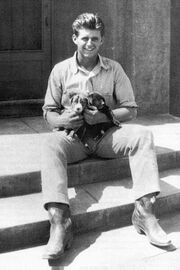





Joseph Patrick "Joe" Kennedy Jr. was born on July 25, 1915 and was the oldest child of Joseph and Rose Kennedy.
Early Life and Education[]
Joe first attended the Dexter School in Brookline, Massachusetts, with his brother, Jack. Joe graduated from The Choate School (now Choate Rosemary Hall) in 1933 in Wallingford, Connecticut. He then entered Harvard College in Cambridge, Massachusetts, graduating in 1938. At Harvard Joe participated in football, rugby, and crew, and he served on the student council. Before he went away to war, he became briefly engaged to Athalia Ponsell, a model and actress. Joe then spent a year studying under the tutelage of Harold Laski at the London School of Economics before enrolling in Harvard Law School.
Political Career[]
From a very young age, Joe was groomed by his father and predicted to be the first Roman Catholic Irish-American President of the United States. When he was born, his grandfather John F. Fitzgerald (1863–1950), then Mayor of Boston, told the news, "This child is the future President of the nation." He often boasted that he would be president even without help from his father. Joseph Kennedy Jr. was dating the Brazilian born Aimée de Sa Sottomajor, later Aimée de Heeren. Aimée was seen as another asset to his political career, as she was considered by the International fashion press to be one of the world's most beautiful woman. Joseph's 3 brothers were also fascinated by Aimée and Ted Kennedy stayed in touch with her until her death in 2006.
Joe was a delegate to the Democratic National Convention in 1940 and planned to run for Massachusetts's 11th congressional district in 1946. He and his father had begun laying the groundwork for the campaign when he was killed.
Military Service, Death and Legacy[]
Joe left Harvard Law School before his final year to volunteer as a navy flier. Awarded his wings in May 1942, he flew Caribbean patrols and in September 1943 was sent to England with the first naval squadron to fly B-24's with the British Naval Command. His military service, which ended with his death on August 12, 1944, was described as follows by his brother, John F. Kennedy:
"His squadron, flying in the bitter winter over the Bay of Biscay, suffered heavy casualties, and by the time Joe had completed his designated number of missions in May, he had lost his former co-pilot and a number of close friends.
"Joe refused his proffered leave and persuaded his crew to remain on for D-day. They flew frequently during June and July, and at the end of July they were given another opportunity to go home. He felt it unfair to ask his crew to stay on longer, and they returned to the United States. He remained. For he had heard of a new and special assignment for which volunteers had been requested which would require another month of the most dangerous type of flying.
"...It may be felt, perhaps, that Joe should not have pushed his luck so far and should have accepted his leave and come home. But two facts must be borne in mind. First, at the time of his death, he had completed probably more combat missions in heavy bombers than any other pilot of his rank in the Navy and therefore was preeminently qualified, and secondly, as he told a friend early in August, he considered the odds at least fifty-fifty, and Joe never asked for any better odds than that."
The secret mission on which he lost his life was described by a fellow officer after it was declassified:
"Joe, regarded as an experienced Patrol Plane Commander, and a fellow-officer, an expert in radio control projects, was to take a 'drone' Liberator bomber loaded with 21,170 pounds of high explosives into the air and to stay with it until two 'mother' planes had achieved complete radio control over the drone. They were then to bail out over England; the "drone," under the control of the mother planes, was to proceed on the mission which was to culminate in a crash-dive on the target, a V-2 rocket launching site in Normandy. The airplane ... was in flight with routine checking of the radio controls proceeding satisfactorily, when at 6:20 p.m. on August 12, 1944, two explosions blasted the drone resulting in the death of its two pilots. No final conclusions as to the cause of the explosions has ever been reached.
"Joe was posthumously awarded the Navy Cross ... and also the Air Medal ... In 1946 a destroyer, the USS Joseph P. Kennedy, Jr., destroyer No. 850, was launched at the Fore River shipyards as the Navy's final tribute to a gallant officer and his heroic devotion to duty...."
The Destroyer USS Joseph P. Kennedy, Jr. DD850 is now a museum in Battleship Cove, Fall River, Massachusetts. In 1946, the Joseph P. Kennedy, Jr. Foundation was established by Ambassador and Mrs. Joseph P. Kennedy to honor their eldest son. The Foundation aims to improve the way society deals with its citizens who have intellectual disabilities (mental retardation) and to help identify and disseminate ways to prevent the causes of intellectual disabilities.


